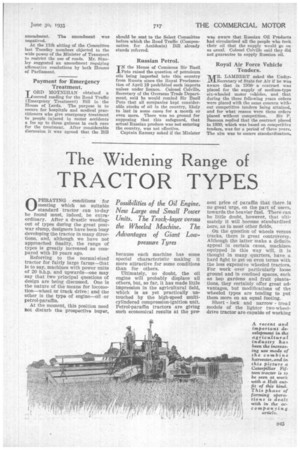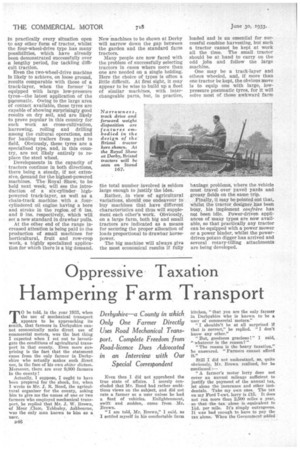The Widening Range of
Page 95

Page 96

If you've noticed an error in this article please click here to report it so we can fix it.
TRACTOR TYPES
Possibilities of the Oil Engine. New Large and Small Power Units. The Track-layer versus the Wheeled Machine. The Advantages of Giant Low
pressure Tyres OPERATING conditions for meeting which no suitable standard tractor can to-day be found must, indeed, be extraordinary. After a drastic weedingout of types during the great postwar slump, designers have been busy developing the tractor in many directions, and, although we have not approached finality, the range of types is greatly increased as compared with 10 years ago.
Referring to the normal-sized tractor for fairly large farms—that is to say, machines with power units of 20 b.h.p. and upwards—one may say that two principal questions of design are being discussed. One is the nature of the means for locomotion—wheel or track drive; and the other is the type of engine—oil or petrol-paraffin.
At the moment, this position need not disturb the prospective buyer, because each machine has some special characteristic making it more attractive for some conditions than for others.
Ultimately, no doubt, the oil engine will probably displace all others, but, so far, it has made little impression in the agricultural field, which is as yet practically untouched by the high-speed multicylindered compression-ignition unit. Petrol-paraffin tractors are giving such economical results at the pre.
sent price of paraffin that there is no great urge, on the part a users, towards the heavier fuel. There can be little doubt, however, that ultimately it will become standardized here, as in most other fields.
On the question of wheels versus tracks, there is great controversy. Although the latter make a definite appeal in certain cases, machines equipped in this way will. it is thought in many quarters, have a hard fight to get on even terms with the less expensive wheeled tractors. For work over particularly loose ground and in confined spaces, suck as hop gardens and fruit plantations, they certainly offer great advantages, but modifications of the wheeled types are tending to put them more on an equal footing.
Short lock and narrow tread models of the lighter two-wheeldrive tractor are capable of working In practically every situation open to any other form of tractor, whilst the four-wheel-drive type has many possibilities, which have already been demonstrated successfully over a lengthy period, for tackling difficult traction.
Even the two-wheel-drive machine Is likely to achieve, on loose ground, results comparable with those of a track-layer, when the former is equipped with large low-pressure tyres—the latest application of the pneumatic. Owing to the large area of contact available, these tyres are capable of showing surprisingly good results on dry soil, and are likely to prove popular in this country for such work as cross-cultivation, harrowing, rolling and drilling among the cultural operations, and for hauling trailers from yard to field. Obviously, these tyres are a specialized type, and, in this country, are not likely entirely to replace the steel wheel.
Developments in the capacity of tractors continue in both directions, there being a steady, if not extensive, demand for the highest-powered machines. The Royal Show, to be held next week, will see the introduction of a six-cylinder highpowered track-layer, as well as a chain-track machine with a Jourcylindered oil engine having a bore and stroke in the region. of 6 ins. and 9 ins. respectively, which will set a new standard in drawbar pulls.
At the other end of the range increased attention is being paid to the production of small machines for horticultural, fruit and row-crop work, a highly specialized application for which there is a big demand. New machines to be shown at Derby will narrow down the gap between the garden and the standard farm tractors.
Many people are now faced with the problem of successfully selecting tractors in cases where more than one are needed on a single holding. Here the choice of types is often a little difficult. At first sight, it may appear to be wise to build up a fleet of similar machines, with interchangeable parts, but, in practice, the total number involved is seldom large enough to justify the idea.
Rather, in view of agricultural variations, should one endeavour to buy machines that have different characteristics and thus will supplement each other's work. Obviously, on a large farm, both big and small tractors are indicated as a means for securing the proper allocation of loads proportional to drawbar horsePower.
The big machine will always give the most economical results if fully loaded and is an essential for successful combine harvesting, but such a tractor cannot be kept at work all the time. The small tractor should be at hand to carry on the odd jobs and follow the large machine.
One may be a track-layer and others wheeled, and, if more than one tractor be kept, the obvious move is to equip one with large, lowpressure pneumatic tyres, for it will solve most of those awkward farm
haulage problems, where the vehicle must travel over paved yards and greasy fields on the same trip.
Finally, it may be pointed out that, whilst the tractor, designer has been busy, his implement confrere has not been idle. Power-driven appliances of many types are now available, so that practically any tractor can be equipped with a power mower or a power binder, whilst the powerdriven potato digger has arrived and several rotary-tilling attachrnents are being developed.




















































































































































